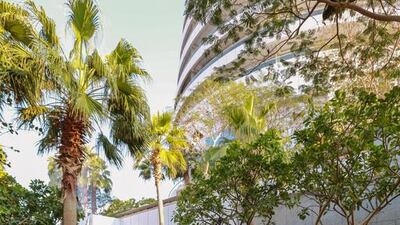DUBAI // Cladding on The Address Downtown Dubai facade did not meet fire safety requirements, a preliminary on-site inspection revealed.
Although the cause of the New Year’s Eve blaze has yet to be confirmed, a senior Civil Defence official said the cladding that lined the outside of the 63-storey hotel did not meet standards.
“The cause of the fire and the primary observations can only be confirmed when the final investigation is completed by the Dubai Police. Our primary on-site initial inspection on the fire at The Address hotel was that the cladding does not meet the required specifications,” said Lt Col Jamal Ahmed Ibrahim, director of the preventive safety department for Dubai Civil Defence.
He was speaking on the sidelines of a meeting to announce next week’s Intersec 2016 security conference and exhibition.
The hotel’s developer, Emaar, said it would wait for the final report.
“All our buildings are developed as per the specifications by the concerned authorities. The buildings are tested periodically and cleared for adhering to the regulatory standards,” a spokeswoman said.
“We will await the final and official report instead of speculating.”
Lt Col Ibrahim said the exterior and interior of all buildings would now be surveyed to check if they were fire-safe following The Address fire.
Owners and developers would be allotted a time frame to adhere to recommended alterations, ranging from changing the facade to installing fire protection barriers.
A new fire safety code to be released in March will put responsibility on owners and consultants in the event hazards identified are not fixed.
“The second day after the fire we held meetings so this does not happen again. We will start a survey for all buildings, not just in Dubai, to find solutions. Each building will have a different solution,” Lt Col Ibrahim said, adding more attention would be paid to buildings with cladding.
“We will find out if cladding is approved, installation is OK. The law is very clear that the owner is responsible for the building so after the survey if some issue is found, the owner will have to replace what needs to be replaced. We are focused on saving lives; that is important to us.”
Fourteen people suffered minor injuries, one person was moderately injured, while another had a heart attack in The Address blaze hours before New Year’s Eve fireworks at the nearby Burj Khalifa.
The new safety changes are being relayed through meetings with developers, which took place on Monday, workshops for cladding suppliers yesterday and municipalities today.
The updated code will state the final facade product must be tested and consultants will be responsible for the structure for at least a year after project delivery.
The 2012 Tamweel Tower blaze that left hundreds homeless was fuelled by combustible aluminium panelling.
With the nationwide 2012 Fire and Life Safety code, authorities sought to phase out non-fire-rated cladding, consisting of a combustible thermoplastic core sandwiched between aluminium sheets. But concern remained about structures predating the code.
Citing the Tamweel repair work, Lt Col Ibrahim said Civil Defence insisted that cladding on all four sides be replaced instead of only the fire-damaged section. Refuting expert estimates that between 65 per cent and 70 per cent of UAE buildings had some form of aluminium panels surrounding a thermoplastic core, Lt Col Ibrahim said only 10 per cent to 20 per cent were covered with cladding.
Plans were also announced to improve safety awareness.
“We will train 1,000 fire fighters every year compared with 300 national recruits trained currently,” said Aiad Mushaikh, project director of the Emirates Academy of Civil Defence Sciences.
“Public fire safety courses will be increased to cover 400,000 per year by 2020 from the 120,000 [at present]. We want people to know how to use fire extinguishers and be safety officers.”
rtalwar@thenational.ae


